Page 23 of 446
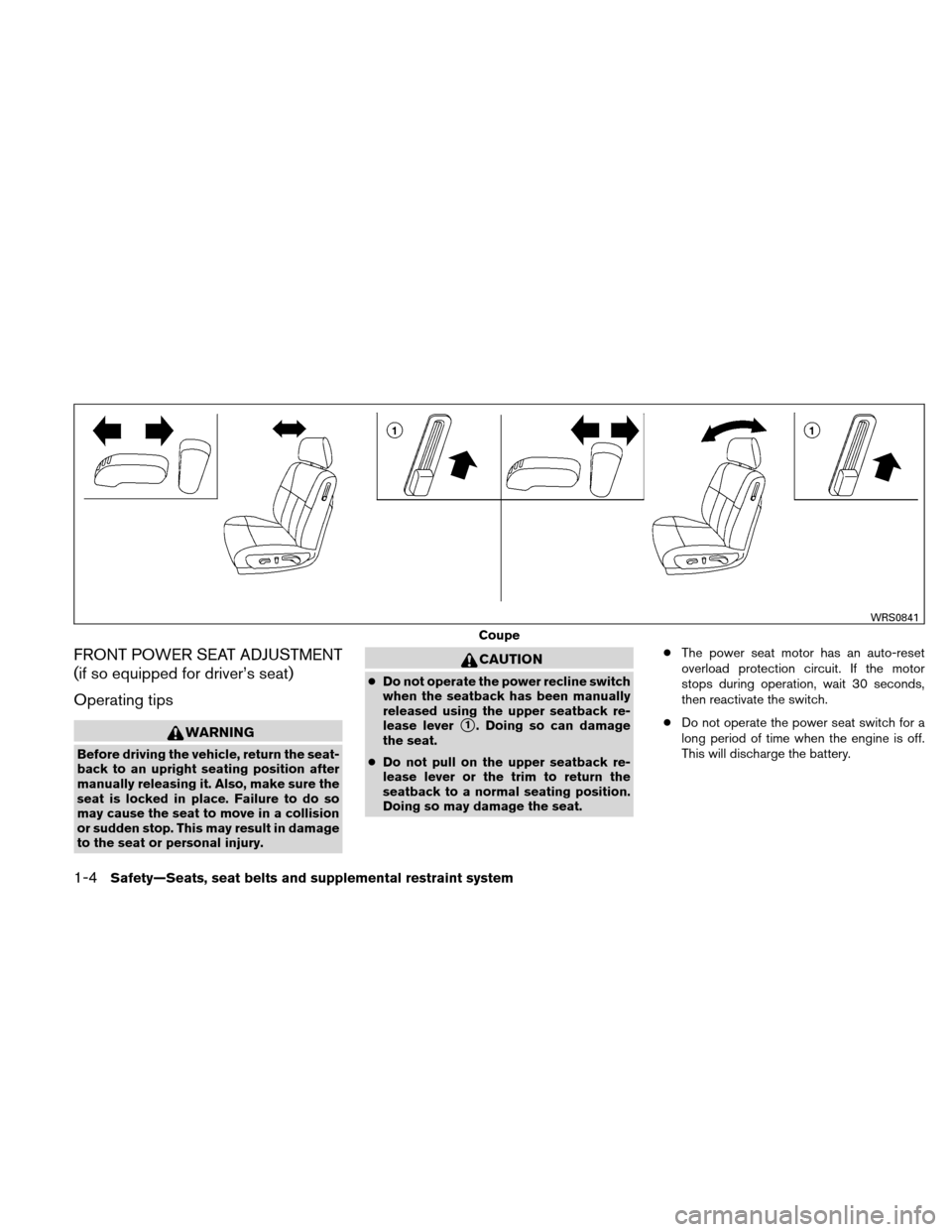
FRONT POWER SEAT ADJUSTMENT
(if so equipped for driver’s seat)
Operating tips
WARNING
Before driving the vehicle, return the seat-
back to an upright seating position after
manually releasing it. Also, make sure the
seat is locked in place. Failure to do so
may cause the seat to move in a collision
or sudden stop. This may result in damage
to the seat or personal injury.
CAUTION
●Do not operate the power recline switch
when the seatback has been manually
released using the upper seatback re-
lease lever
�1. Doing so can damage
the seat.
● Do not pull on the upper seatback re-
lease lever or the trim to return the
seatback to a normal seating position.
Doing so may damage the seat. ●
The power seat motor has an auto-reset
overload protection circuit. If the motor
stops during operation, wait 30 seconds,
then reactivate the switch.
● Do not operate the power seat switch for a
long period of time when the engine is off.
This will discharge the battery.
Coupe
WRS0841
1-4Safety—Seats, seat belts and supplemental restraint system
Page 24 of 446
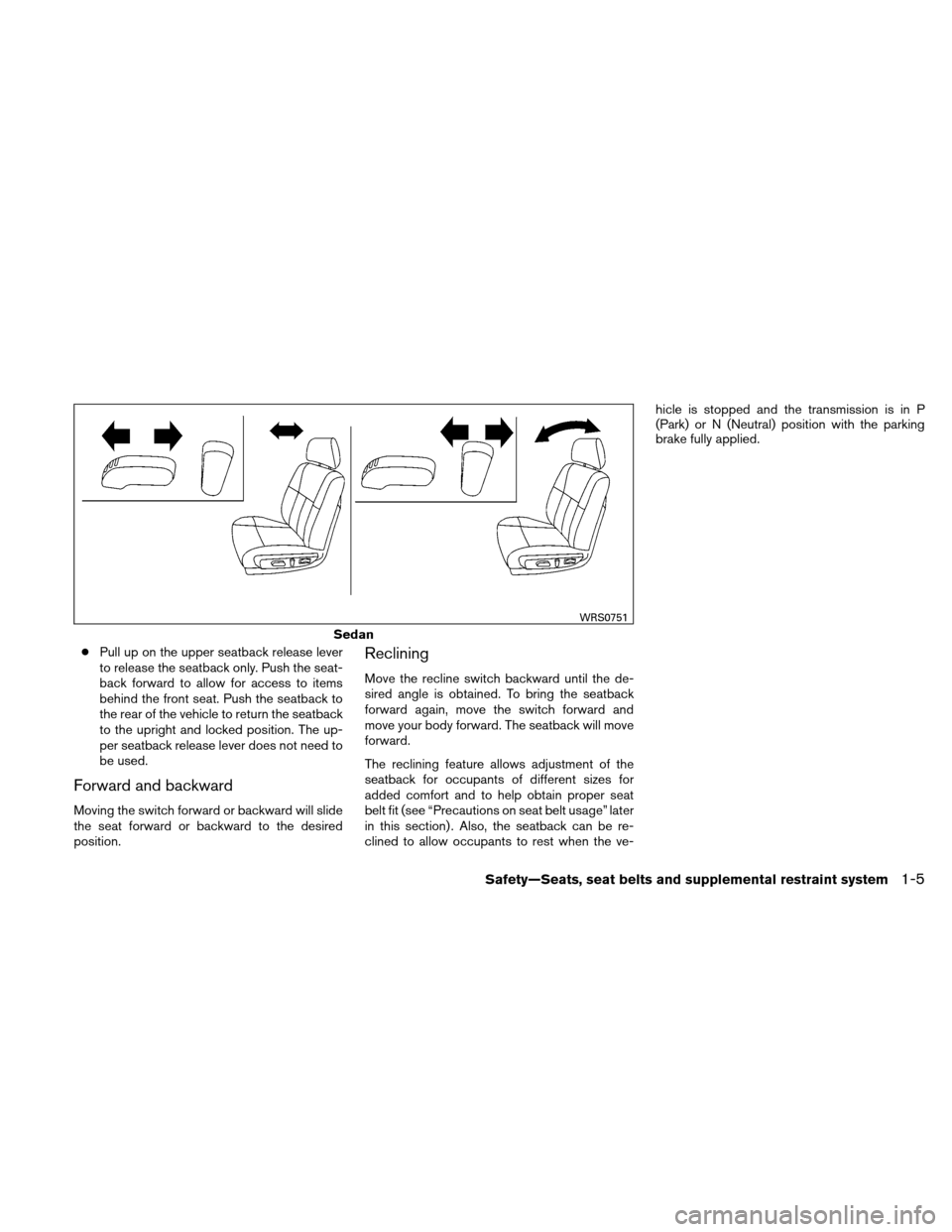
●Pull up on the upper seatback release lever
to release the seatback only. Push the seat-
back forward to allow for access to items
behind the front seat. Push the seatback to
the rear of the vehicle to return the seatback
to the upright and locked position. The up-
per seatback release lever does not need to
be used.
Forward and backward
Moving the switch forward or backward will slide
the seat forward or backward to the desired
position.
Reclining
Move the recline switch backward until the de-
sired angle is obtained. To bring the seatback
forward again, move the switch forward and
move your body forward. The seatback will move
forward.
The reclining feature allows adjustment of the
seatback for occupants of different sizes for
added comfort and to help obtain proper seat
belt fit (see “Precautions on seat belt usage” later
in this section) . Also, the seatback can be re-
clined to allow occupants to rest when the ve- hicle is stopped and the transmission is in P
(Park) or N (Neutral) position with the parking
brake fully applied.
Sedan
WRS0751
Safety—Seats, seat belts and supplemental restraint system1-5
Page 26 of 446
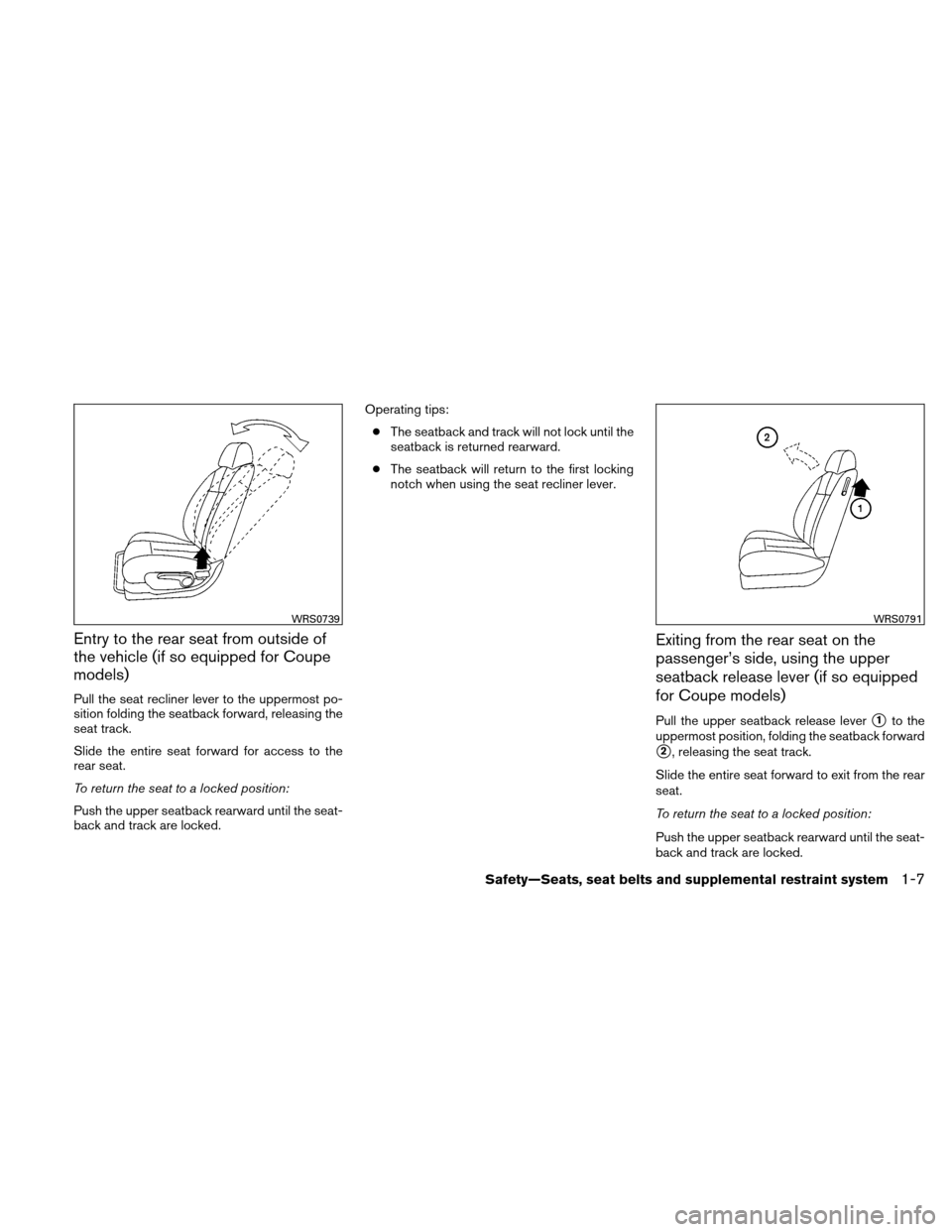
Entry to the rear seat from outside of
the vehicle (if so equipped for Coupe
models)
Pull the seat recliner lever to the uppermost po-
sition folding the seatback forward, releasing the
seat track.
Slide the entire seat forward for access to the
rear seat.
To return the seat to a locked position:
Push the upper seatback rearward until the seat-
back and track are locked.Operating tips:
● The seatback and track will not lock until the
seatback is returned rearward.
● The seatback will return to the first locking
notch when using the seat recliner lever.
Exiting from the rear seat on the
passenger’s side, using the upper
seatback release lever (if so equipped
for Coupe models)
Pull the upper seatback release lever�1to the
uppermost position, folding the seatback forward
�2, releasing the seat track.
Slide the entire seat forward to exit from the rear
seat.
To return the seat to a locked position:
Push the upper seatback rearward until the seat-
back and track are locked.
WRS0739WRS0791
Safety—Seats, seat belts and supplemental restraint system1-7
Page 27 of 446
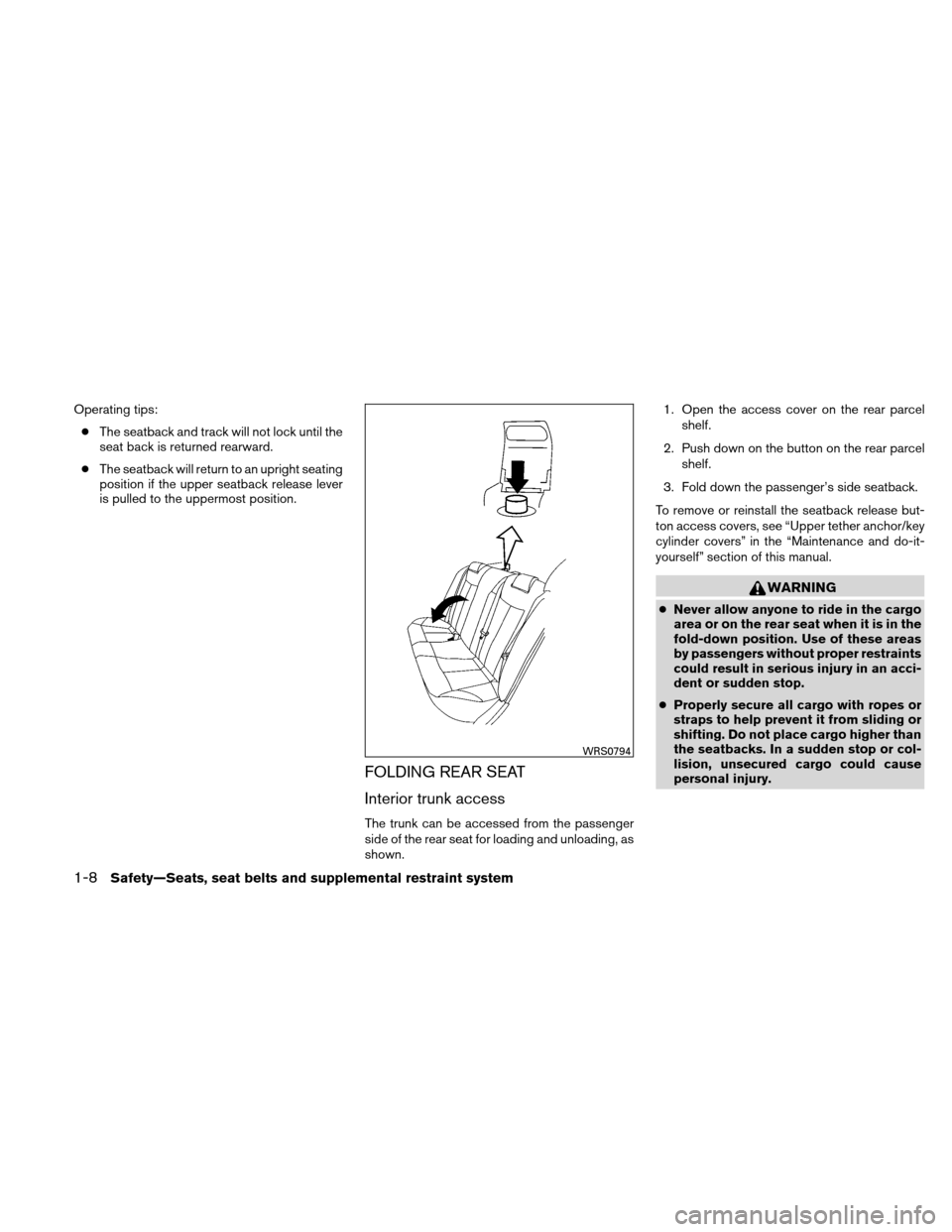
Operating tips:● The seatback and track will not lock until the
seat back is returned rearward.
● The seatback will return to an upright seating
position if the upper seatback release lever
is pulled to the uppermost position.
FOLDING REAR SEAT
Interior trunk access
The trunk can be accessed from the passenger
side of the rear seat for loading and unloading, as
shown. 1. Open the access cover on the rear parcel
shelf.
2. Push down on the button on the rear parcel shelf.
3. Fold down the passenger’s side seatback.
To remove or reinstall the seatback release but-
ton access covers, see “Upper tether anchor/key
cylinder covers” in the “Maintenance and do-it-
yourself” section of this manual.
WARNING
● Never allow anyone to ride in the cargo
area or on the rear seat when it is in the
fold-down position. Use of these areas
by passengers without proper restraints
could result in serious injury in an acci-
dent or sudden stop.
● Properly secure all cargo with ropes or
straps to help prevent it from sliding or
shifting. Do not place cargo higher than
the seatbacks. In a sudden stop or col-
lision, unsecured cargo could cause
personal injury.
WRS0794
1-8Safety—Seats, seat belts and supplemental restraint system
Page 28 of 446
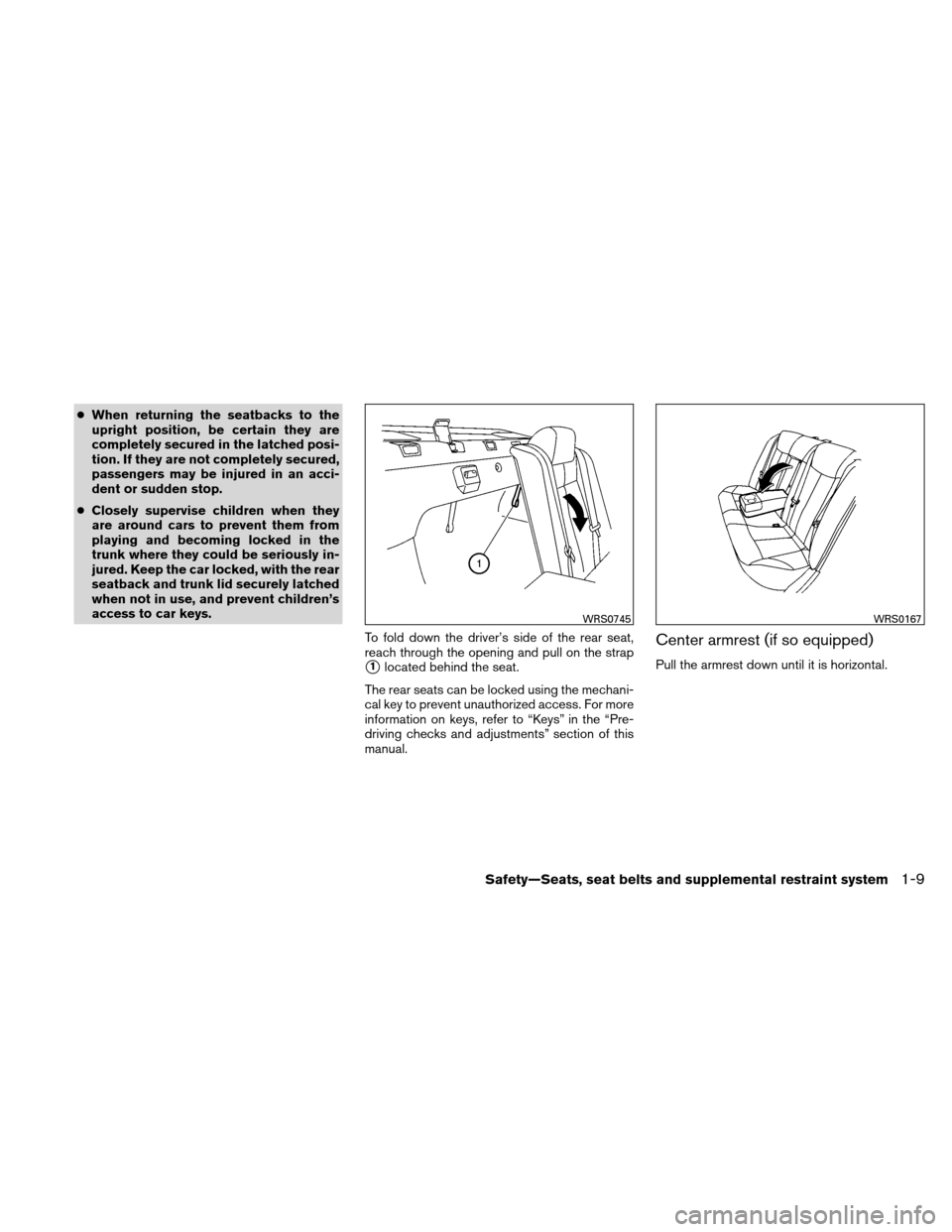
●When returning the seatbacks to the
upright position, be certain they are
completely secured in the latched posi-
tion. If they are not completely secured,
passengers may be injured in an acci-
dent or sudden stop.
● Closely supervise children when they
are around cars to prevent them from
playing and becoming locked in the
trunk where they could be seriously in-
jured. Keep the car locked, with the rear
seatback and trunk lid securely latched
when not in use, and prevent children’s
access to car keys.
To fold down the driver’s side of the rear seat,
reach through the opening and pull on the strap
�1located behind the seat.
The rear seats can be locked using the mechani-
cal key to prevent unauthorized access. For more
information on keys, refer to “Keys” in the “Pre-
driving checks and adjustments” section of this
manual.
Center armrest (if so equipped)
Pull the armrest down until it is horizontal.
WRS0745WRS0167
Safety—Seats, seat belts and supplemental restraint system1-9
Page 29 of 446
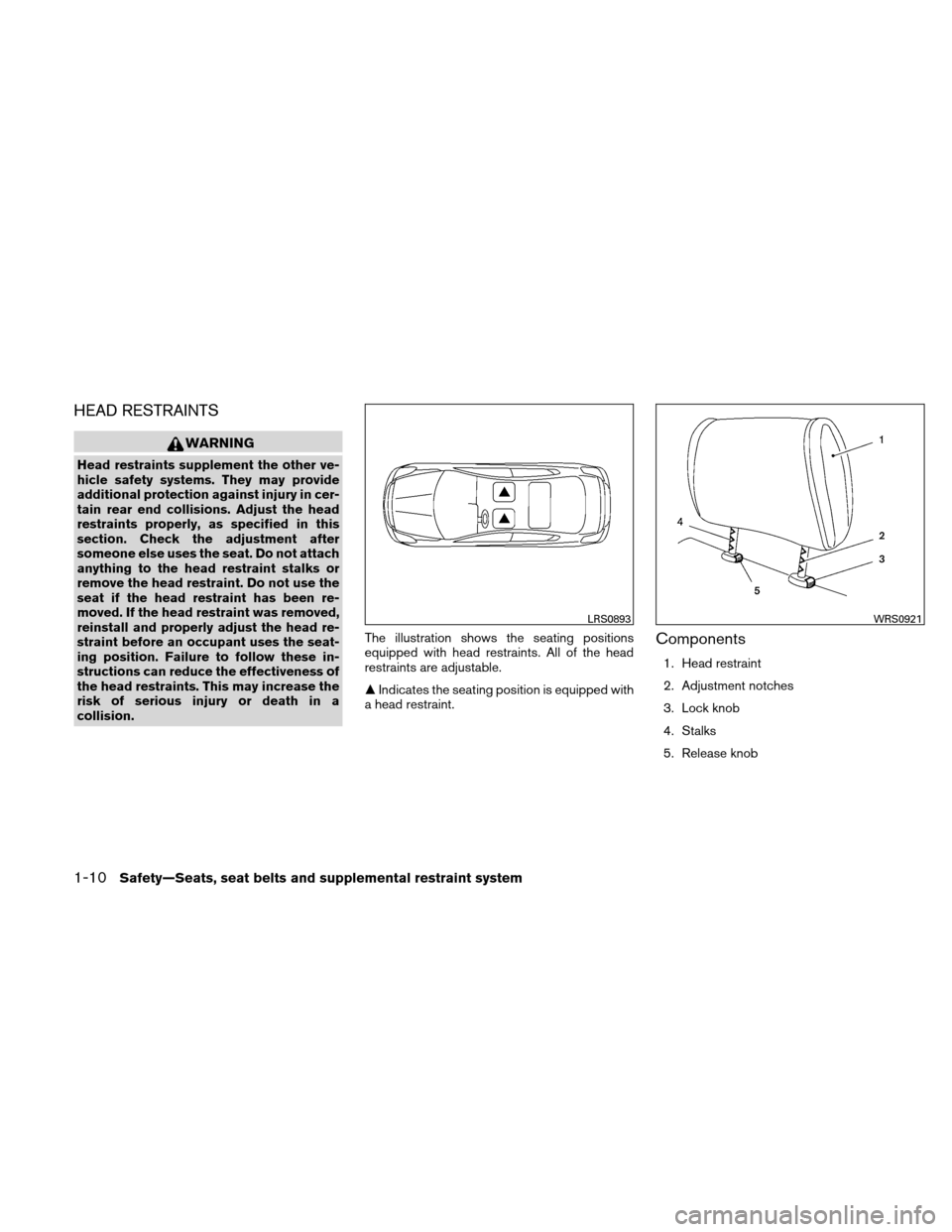
HEAD RESTRAINTS
WARNING
Head restraints supplement the other ve-
hicle safety systems. They may provide
additional protection against injury in cer-
tain rear end collisions. Adjust the head
restraints properly, as specified in this
section. Check the adjustment after
someone else uses the seat. Do not attach
anything to the head restraint stalks or
remove the head restraint. Do not use the
seat if the head restraint has been re-
moved. If the head restraint was removed,
reinstall and properly adjust the head re-
straint before an occupant uses the seat-
ing position. Failure to follow these in-
structions can reduce the effectiveness of
the head restraints. This may increase the
risk of serious injury or death in a
collision.The illustration shows the seating positions
equipped with head restraints. All of the head
restraints are adjustable.
�
Indicates the seating position is equipped with
a head restraint.
Components
1. Head restraint
2. Adjustment notches
3. Lock knob
4. Stalks
5. Release knob
LRS0893WRS0921
1-10Safety—Seats, seat belts and supplemental restraint system
Page 30 of 446
Adjustment
Adjust the head restraint so the center is level
with the center of the seat occupant’s ears.To raise the head restraint, pull it up.
To lower, push and hold the lock knob and push
the head restraint down.
WRS0134LRS0888LRS0889
Safety—Seats, seat belts and supplemental restraint system1-11
Page 31 of 446
Removal
Use the following procedure to remove the ad-
justable head restraints.1. Pull the head restraint up to the highest position.
2. Push and hold the lock knob and release knob.
3. Remove the head restraint from the seat.
4. Store the head restraint properly so it is not loose in the vehicle. 5. Reinstall and properly adjust the head re-
straint before an occupant uses the seating
position.
Install
1. Align the head restraint stalks with the holesin the seat. Make sure the head restraint is
facing the correct direction.
2. Push and hold the lock knob and push the head restraint down.
3. Properly adjust the head restraint before an occupant uses the seating position.
WRS0922LRS2026
1-12Safety—Seats, seat belts and supplemental restraint system